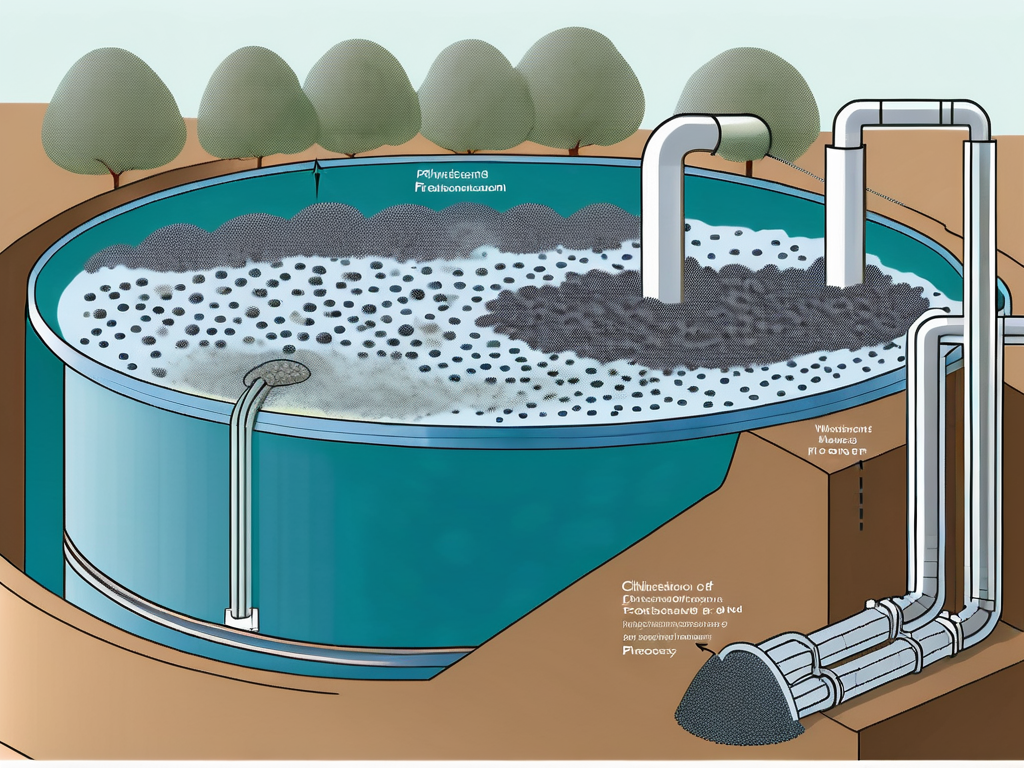
Flocculation: Wastewater Treatment Explained
Flocculation is a critical process in the treatment of wastewater, playing a pivotal role in the removal of contaminants and the overall improvement of water quality. This process involves the aggregation of fine particles into larger clumps, known as flocs, which can be more easily removed from the water. The process of flocculation is a complex one, involving a number of stages and factors which will be explored in this comprehensive glossary entry.
Understanding the process of flocculation is essential for those involved in wastewater treatment, as it is a key step in the process of purifying water and returning it to the environment in a safe and clean state. This glossary entry will provide a detailed and thorough exploration of the process of flocculation, its role in wastewater treatment, and the factors that influence its effectiveness.
The Process of Flocculation
Flocculation is a physical process that involves the clumping together of fine particles into larger masses, or flocs. This process is facilitated by the addition of chemicals, known as flocculants, which encourage the particles to aggregate. The resulting flocs are larger and heavier than the individual particles, making them easier to separate from the water.
The process of flocculation is a critical one in wastewater treatment, as it allows for the effective removal of contaminants from the water. By aggregating the particles into larger flocs, they can be more easily separated from the water, resulting in cleaner, safer water that can be returned to the environment.
Stages of Flocculation
The process of flocculation involves several stages. The first stage is the addition of the flocculant, which is typically a chemical compound that encourages the particles to aggregate. The flocculant is mixed with the wastewater, allowing it to interact with the particles and initiate the flocculation process.
The second stage of flocculation is the actual aggregation of the particles. This occurs as the flocculant binds to the particles, causing them to clump together into larger flocs. The size and density of the flocs can be influenced by a number of factors, including the type and concentration of the flocculant, the characteristics of the particles, and the conditions of the wastewater.
Types of Flocculants
There are several types of flocculants that can be used in the flocculation process, each with their own characteristics and uses. These include inorganic flocculants, organic flocculants, and biological flocculants. The choice of flocculant depends on the specific requirements of the wastewater treatment process and the nature of the contaminants present in the water.
Inorganic flocculants are typically salts of multivalent metals, such as aluminium or iron. These flocculants work by neutralizing the charge on the particles, allowing them to aggregate. Organic flocculants, on the other hand, are typically polymers that work by bridging the particles together. Biological flocculants are naturally occurring substances that can encourage flocculation, and are often used in the treatment of organic waste.
Role of Flocculation in Wastewater Treatment
Flocculation plays a critical role in the treatment of wastewater, facilitating the removal of contaminants and improving the overall quality of the water. By aggregating the fine particles into larger flocs, the process of flocculation allows for the effective separation of contaminants from the water.

The flocs formed during the flocculation process are larger and heavier than the individual particles, making them easier to separate from the water. This is typically achieved through a process known as sedimentation, where the flocs settle to the bottom of the water due to gravity. The flocs can then be removed, resulting in cleaner water that can be further treated or returned to the environment.
Removal of Contaminants
One of the primary roles of flocculation in wastewater treatment is the removal of contaminants. The process of flocculation allows for the aggregation of fine particles, which can include contaminants such as bacteria, viruses, heavy metals, and organic matter. By clumping these particles together into larger flocs, they can be more easily separated from the water, resulting in cleaner, safer water.
The effectiveness of flocculation in removing contaminants can be influenced by a number of factors, including the type and concentration of the flocculant, the characteristics of the particles, and the conditions of the wastewater. By optimizing these factors, the efficiency of the flocculation process can be maximized, resulting in more effective wastewater treatment.
Improvement of Water Quality
In addition to removing contaminants, the process of flocculation also plays a role in improving the overall quality of the water. By removing fine particles and contaminants, the clarity and color of the water can be improved, making it more suitable for further treatment or return to the environment.
The process of flocculation can also help to reduce the biological oxygen demand (BOD) and chemical oxygen demand (COD) of the water, which are measures of the amount of oxygen required to break down organic matter in the water. By removing organic matter through flocculation, the BOD and COD of the water can be reduced, improving its overall quality.
Factors Influencing Flocculation
The effectiveness of the flocculation process can be influenced by a number of factors. These include the type and concentration of the flocculant, the characteristics of the particles, and the conditions of the wastewater. Understanding these factors is critical for optimizing the flocculation process and maximizing the efficiency of wastewater treatment.
The type and concentration of the flocculant can have a significant impact on the flocculation process. Different types of flocculants have different properties and can be more or less effective at aggregating particles, depending on the specific requirements of the wastewater treatment process. The concentration of the flocculant can also influence the size and density of the flocs, with higher concentrations typically resulting in larger, denser flocs.
Particle Characteristics
The characteristics of the particles in the wastewater can also influence the effectiveness of the flocculation process. Factors such as the size, shape, and charge of the particles can all impact their ability to aggregate and form flocs. For example, smaller particles may require more flocculant to aggregate, while particles with a high charge may be more resistant to flocculation.
The nature of the contaminants present in the wastewater can also impact the flocculation process. Certain types of contaminants, such as heavy metals or organic matter, may require specific types of flocculants or specific conditions to effectively flocculate. Understanding the nature of the contaminants is therefore critical for optimizing the flocculation process.
Wastewater Conditions
The conditions of the wastewater can also influence the effectiveness of the flocculation process. Factors such as the pH, temperature, and turbidity of the water can all impact the flocculation process. For example, changes in pH can impact the charge of the particles and the effectiveness of the flocculant, while changes in temperature can impact the rate of flocculation.
The turbidity of the water, which is a measure of the amount of suspended particles in the water, can also influence the flocculation process. High turbidity can increase the demand for flocculant, while low turbidity can result in smaller, less dense flocs. Understanding and controlling these conditions is therefore critical for optimizing the flocculation process and maximizing the efficiency of wastewater treatment.
Conclusion
In conclusion, flocculation is a critical process in the treatment of wastewater, playing a pivotal role in the removal of contaminants and the improvement of water quality. This process involves the aggregation of fine particles into larger flocs, which can be more easily removed from the water. The effectiveness of the flocculation process can be influenced by a number of factors, including the type and concentration of the flocculant, the characteristics of the particles, and the conditions of the wastewater.

Understanding the process of flocculation and the factors that influence its effectiveness is essential for those involved in wastewater treatment. By optimizing these factors, the efficiency of the flocculation process can be maximized, resulting in more effective wastewater treatment and cleaner, safer water that can be returned to the environment.



